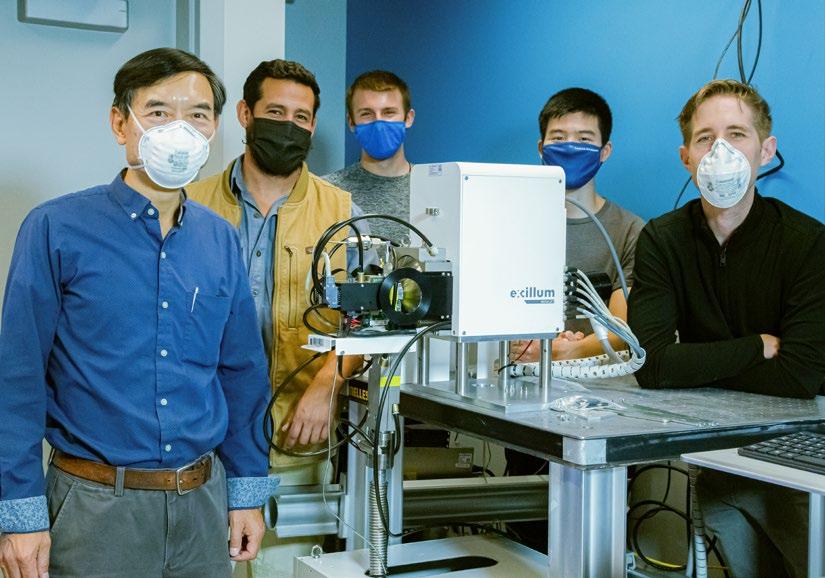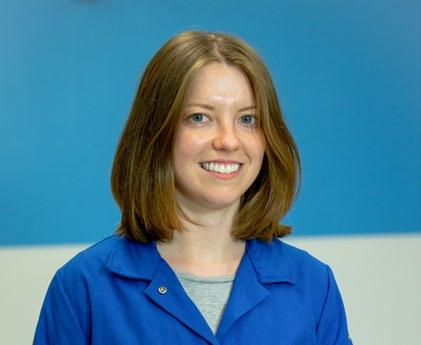
12 minute read
Tech Edge


Advertisement




Leading-edge Instrumentation that Makes the BioPACIFIC MIP Go
When it comes to collaborating, few R1 universities can match UC Santa Barbara, especially in engineering and other instrumentation-intensive STEM disciplines. The ability and willingness of diverse departments to cooperate — and the support for such reciprocal sharing provided by Chancellor Henry T. Yang and other key administrators — have been critical to enabling UCSB to achieve world standing in multiple STEM disciplines.
That uniquely collaborative environment — refl ected to tremendous effect in the College of Engineering — has been instrumental in securing major funding for such entities as the Materials Research Science & Engineering Center (MRSEC, aka the Materials Research Lab), the Quantum Foundry, and, most recently, the BioPolymers, Automated Cellular Infrastructure, Flow, and Integrated Chemistry Materials Innovation Platform (BioPACIFIC MIP).
Such grants have also enabled UCSB to build a world-class array of leading-edge laboratory equipment and instrumentation. In this new series, “Tech Edge,” we will highlight some of those instruments and how they serve the research enterprise, while meeting some of the people who operate and maintain them. We begin with three facilities — for small-angle X-ray diffraction (XRD), for additive manufacturing (aka 3D printing), and for automated chemistry, all part of the BioPACIFIC MIP. The fi ve-year, $23.5 million collaboration with UC Los Angeles is aimed at building and operating a fi rst-of-its-kind platform dedicated to the accelerated discovery and development of new high-performance, bio-derived materials. As an NSF platform program, the MIP is intended to provide tools and techniques to enable new approaches to scientifi c discovery.
“High-throughput” is foundational to the MIP, and everything related to it is being built or modifi ed with the goal of rapidly discovering and synthesizing promising new materials, characterizing those materials at atomic and molecular scales, computationally simulating their behavior across a range of spatial and time scales, building libraries of new molecules and polymers for researchers around the world to use, and providing feedback to inform further refi nement and discovery. Each of the three facilities described in this edition of “Tech Edge” is essential to that collaborative effort.


X-ray Di raction: Youli Li TECH EDGE
Microscopy and X-ray diffraction (XRD) are two of the most commonly used techniques for characterizing the structure of new materials. A highly advanced small-angle X-ray scattering (SAXS) instrument, which is a special application of the XRD technique for large-scale structures, is being built at UCSB to study the nano-structures of new materials produced in the BioPACIFIC MIP.
In traditional optical microscopy, light and lenses combine to provide direct observation of a sample magnifi ed many times. Electron microscopy (EM) employs electrons, which have much shorter wavelengths than photons, to achieve the much-higher resolution required to “see” the atomic structure of a material. Electron microscopy, however, is primarily a surface imaging tool. The electrons from the beam interact strongly with the material, so they are absorbed quickly within the surface slice, preventing them from penetrating deeper and conveying information from any subsurface region of the material.
X-ray diffraction, says Youli Li, who leads UCSB’s XRD facility, “is quite the opposite.” He explains that X-rays can penetrate deep into a material, with some X-rays bouncing off the electrons along the beam path, in a process called scattering, to produce a diffraction pattern that resembles an image of peaks and valleys. A computer is then used to mathematically transform that pattern into an image revealing how the atoms and molecules are arranged throughout the entire volume of the material. Thus, the information provided by X-ray diffraction is complementary to that of electron microscopy.
“The X-rays we use are well suited for looking at atomic and molecular structure, because their wavelength is so small, about the size of an atom, and that is the yardstick you’re using to make measurements,” Li explains. “In the optical range, the wavelength is on the order of a few thousand angstroms — a few hundred nanometers — so you can see detail down to the micron size. X-rays are about a thousand times smaller, providing a clear advantage.”
For the MIP, Li and his team are expanding and enhancing the COE’s XRD capability to facilitate high-throughput characterization of new materials. “We have been doing XRD for a long time and are well known, especially in small-angle X-ray scattering of biological and polymer structures, like those to be made in the MIP,” Li notes. “When we applied for the MIP, we asked ourselves what tools we would need and how we could advance the SAXS technique to speed up discovery and give us one of the best instruments in the world.”
An XRD consists of a source to pump out X-rays and a detector to read them. Li and his team decided to pursue an SAXS system that would have the brightest X-ray source available for a non-national lab setting in the world, coupled to the most advanced high-sensitivity detector to count individual x-ray photons.
“Our competitor will be the network of billion-dollar national facilities, called synchrotrons,” Li says, “but we will have an instrument that allows you to just walk in and do a measurement.”
Concentrated on diffraction (from left): facility director, Youli Li, R&D engineer Miguel Zepeda-Rosales, undergraduate assistants Ryan Williat and Alvin Pan, and staff specialist Phillip Krohl with new X-ray source. And do that measurement quickly, leading Li to say that the new SAXS instrument “absolutely fi ts in” with the high-throughput nature of the BioPACIFIC MIP, thanks to engineering his team has done in building it. “High throughput means being able to examine multiple samples, quickly and effi ciently, while minimizing dead time between them,” he says. “You want to be able to load as many samples as possible, and we’re building in a lot of automation and robotics so that you can automatically align the sample quickly and point an X-ray at it, normally a time-consuming process. “Part of the reason we decided to build the instrument ourselves was because this combination of the brightest source and the best detector is not commercially available,” he adds. “Additionally, building in the high-throughput capability to process samples rapidly allows us to serve a larger number of user groups. More important, in my mind, is that we can develop the instrument to meet the needs of possible future applications. The focus of research can shift over time, and we want this tool to be adaptable. We don’t want to build a big, fancy, expensive tool to do just one thing.” He concludes: “We are hugely grateful to have received this NSF funding, and we’re excited for the opportunity to design, engineer, and develop this high-performing instrument for the MIP. We hope that it will allow us to push the envelope in terms of developing new X-ray diffraction techniques, approaches, and methods that other researchers can use as well.”

TECH EDGE Printing Functional Biomaterials: Juan Manuel Urueña
New materials discovered in the BioPACIFIC MIP will, in turn, enable new technologies to arise in the form of novel biomaterial-based devices, treatments, or products. Additive manufacturing, or 3D printing, will play a key role in creating one-off objects made from novel materials for use in a wide variety of applications. Many additive manufacturing techniques are well suited for creating complex structures from very soft solids composed of bio-derived materials.
The BioPACIFIC MIP Additive Manufacturing Facility is directed by MIP project scientist Juan Manuel Urueña. His doctoral research was focused on the energy-dissipation mechanisms of soft aqueous gels, and during his postdoctoral research, he developed microgels for 3D bioprinting and designed infrastructure to support long-term, continuous in-vitro cell and tissue culture in 3D. He says he joined the BioPACIFIC MIP “to engage in collaborative research focused on soft bioderived materials discovery and to expand 3D manufacturing techniques for new biological and bio-inspired materials.”
The facility supports state-of-the-art 3D printing platforms designed specifically for bio-inspired, bio-derived materials providing an alternative to petroleum-based polymers. Conventional manufacturing processes, such as machining, are used to produce solid workpieces that are generally isotropic; that is, they have the same material properties throughout. Additive manufacturing, however, enables the fabrication of soft, anisotropic objects, in which different regions might be chemically and mechanically distinct so that they are optimized for specific functions.
The wide variety of 3D printing approaches employed in the facility includes a custom process developed by UCSB professor of materials and chemistry and MIP co-PI Craig Hawker. Called Solution Mask Liquid Lithography (SMaLL), it enables users to create such intricate anisotropic biomaterialbased structures having a range of material properties within the same 3D printed object.
In addition, the MIP has invested in a suite of 3D printers designed to work with biological samples, such as the Cellink BioX bioprinter, which is capable of precisely arranging living cells and cellular components in a three-dimensional environment. The combination of expertise and state-of-theart equipment positions the facility to have a big impact on such diverse fields as flexible electronics (used in wearable devices and biosensors), smart materials, encapsulation technologies (i.e. enclosing materials into capsules before delivering them into a system), and personalized medicine (such as drug-delivery devices).
In his role leading the Additive Manufacturing Facility, Urueña provides detailed training to those using each of the machines in it, as well as technical advice when users are testing new materials or developing new protocols. “Users benefit from consulting with me and other project scientists to ensure that their experiments go as smoothly as possible,” he says. “I provide technical help and encourage users to submit proposals so that we can provide feedback.”
In terms of what lies ahead for him in the hugely collaborative BioPACIFIC MIP, Urueña says, “I enjoy the scientific challenges that come with working with users from a wide variety of academic backgrounds, and I’m fortunate to be part of a very supportive, collaborative, and multidisciplinary team. A team made up of members who have diverse backgrounds leads to very creative solutions to problems and makes for an enthralling journey to the solution.”


Juan Manuel Urueña in the Additive Manufacturing Facility, where novel materials can be printed for the MIP.
Automated Chemistry Platform: Morgan Bates
Morgan Bates, a project scientist at UCSB who earned her PhD in chemical engineering with a background in chemistry and synthesis, is in charge of the MIP’s “quick chemistry” component, which relies on a unique highthroughput instrument called an automated chemistry platform. “As one of several instruments geared for making the synthesis of biopolymers and related materials easier, more reproducible, and high-throughput,” Bates says, “the platform’s function is basically to mimic all of the synthetic manipulations a chemist would do.”
The system, valued at roughly $1 million, is doubly unique. First, the manufacturer, Chemspeed, is the world’s only supplier of an automated chemistry platform having such automated and robotic capabilities, and second, it had not previously put together a system having as many different functions as the BioPACIFIC MIP team requested.
The box-shaped platform, which was to arrive in November and is about the size of a small car, has a work surface contained within an acrylic enclosure to seal it away from oxygen or other atmospheric contaminants. On the work surface, called a deck, is a series of robotic tools that can dose, or add, reagents in powder or liquid form to a large series of reactors, performing as many as 96 reactions in a single run, something a human would be unlikely to attempt. The choice of a specifi c reactor type depends on whether the reaction requires unique kinds of stimuli, such as light and high pressure or, perhaps, very high or very low temperatures, in order to occur.
Bates explains that, collectively, the robotic tools on the instrument work together to set up and run reactions and do some of the purifi cation steps, such as fi ltration, drying, centrifugation, and solid-phase extraction, that are commonly employed to isolate a small molecule or a polymer.
The instrument’s robotics could also be leveraged by researchers who are examining physical phenomena, enabling them to study a much larger swath of that parameter space than would be possible if the formulations were prepared by hand. A grad student may make only a few samples, because doing so can require signifi cant physical effort, whereas a robot is fi ne with turning out many, many samples, making it possible to vary more parameters or produce more variations within a series of samples.
“The instruments in this facility will allow people to carry out science twenty-fourseven. The robots don’t sleep,” she says. “Their impact results from their ability to conduct non-stop exploration of an immense experimental parameter space.”
The physical advantage the system provides in terms of labor-saving automation also yields a huge intellectual advantage for those doing the science. “When a researcher is able to rest while the physical labor still gets done, that person’s untaxed mind is free to focus deeply on the questions at hand, the end goal, and the relationships that they observe in their generated data,” Bates says.
Users wishing to access the UCSB BioPACIFIC site will submit a proposal and then receive instrument access based on its quality and the appropriateness of the work for the instrumentation available. If approved, Bates says, “It is then my responsibility to help researchers translate their science to our instrumentation. That might mean adapting their process to the automation or, conversely, working with researchers to modify the equipment to make it work for their process.”
The million dollar, custom-built, automated rapid-chemistry plaform, with the most functions that German manufacturer Chemspeed has ever put into one of its systems, will enable rapid-throughput chemistry 24/7. Morgan Bates













